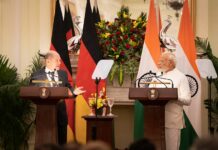From December 2021, India will cease importing complex defence equipment. The Indian
Government has issued a “Second Positive Indigenisation List” of 108 items to promote self-reliance and defence exports.
Denis Leary once said, “One thing that’s great about firefighters: If they don’t have the equipment they desperately need, they don’t have the help, they don’t care. They’ll do it on their own.” The above seems to reflect the driving principle behind India’s defence manufacturing mindset, elucidated by its recent pitch to achieve self-reliance in weaponry.
In a big push for ‘Self-Reliant India’ otherwise known as “Atmanirbhar Bharat” in the vernacular, the Indian Government has released an extended list of defence items to be procured domestically, thereby banning imports of those items as per the timeline given against each item. Labelled the “Second Positive Indigenisation List” of 108 items, the latest list comprises complex systems.
India is among the world’s top five arms importers, as per SIPRI’s latest findings. Having fought five wars with two belligerent neighbours, in what began during the Cold War, India’s domestic defence manufacturing industry never really took off in the way it should have, ending with huge imports, mostly from the erstwhile Soviet Union. Everything from submarines, tanks and fighter jets were Russian. Small steps were taken in the 1950s with the laying of the foundation for homemade weapons, though with little or no success. This was followed by sanctions gripping the nation post nuclear tests, which only accelerated the need for self-reliance. This demand has only intensified over the years, more so last year during the eight-month stand-off at the Indo-China border in northern India’s eastern-Ladakh sector amidst the COVID-19 pandemic.
Aimed at achieving self-reliance, this Indian Government move is expected to boost the active participation of the public and private sector to fulfil the twin objectives of indigenisation and defence exports. As per the provisions listed in the DAP 2020 (Defence Acquisition Procedure) all the listed equipment will be procured domestically from Indian manufacturers.
SP Shukla, Group President Mahindra Defence stated, “The promulgation of the second positive indigenisation list brings together a range of systems, sub-systems and platforms which collectively strengthens the foundation for ‘Atmanirbhar Bharat’
The second list, aimed at reducing dependence on foreign military hardware, focuses on weapon systems which are currently under development or trials and are likely to translate into firm orders in the future. Like the first list, the second one also targets import substitution of ammunition which is a recurring requirement.
Defence Secretary Ajay Kumar stated, “Great news for the Indian Defence Industry. With 101 items notified in August 2020 and 108 items notified now, 209 items not to be imported by Armed Forces from specified dates.”
The exhaustive list prepared by the Ministry of Defence (MoD), and to be hosted on its website, underwent several rounds of consultations with governmental and private manufacturing bases to assess future capabilities of Indian industry and provide the continuous impetus towards self-reliance in defence by providing an excellent opportunity for ‘start-ups’ and the MSMEs (Medium Small Micro Enterprises).
Defence Minister Rajnath Singh, who announced the target of US$25Bn by 2025 for defence manufacturing in India, has mentioned over the last few years the Government’s hope of the industry acting as an engine for growth. Out of US$18.5Bn allocated for capital acquisition for defence in this year’s budget, the Government has reserved more than 60 per cent, approximately US$10Bn, for domestic procurement.
Jayant D Patil, Senior Executive Vice President, Larsen & Toubro Ltd, and President of SIDM (Society of Indian Defence Manufacturers), the largest industry body, says, “Due to COVID-19, the list is late by two months, as it was expected in March. But some real big-ticket items have found their way onto the negative list. All kinds of tanks and numerous tank systems now won’t be imported. That’s one extremely positive statement.”
Patil expressed satisfaction with around half of the items having made it from a list of 250 given by SIDM. He said “we are absolutely clear that there will be a third list and a fourth list also”, as “that clarity existed even when the first list came”.
According to estimates, the Indian Armed Forces are projected to spend around US$130Bn in capital acquisition in the next five years.
Indian Defence Industry
The top five private defence manufacturers in India are the Tata Group, Larsen & Toubro Ltd, Bharat Forge Kalyani Group, Mahindra Defence and Reliance Naval & Engineering Ltd. Insiders confide that, “It is affirming that Indian Industry has capabilities as well as a track record of having done a lot of indigenous development and the list is just a formalisation of the track record and capability of what industry players have done and are capable of doing.”
Though there have been arguable debates over the years about a non-level playing field in awarding defence contracts, which mostly go the Government-owned units, this initiative by the Government puts behind the possibility of anyone in the MoD’s decision-making chain and the armed forces expressing displeasure at the indigenous product and wanting to import it as a deviation from the embargo list. As with the previous list, this too has a lot of complete platforms, system of systems, equipment and major building blocks for platforms.
In some of these cases, it will involve fully capable Indian players who may be able to design and build them on their own, but if they end up being the single vendor, then the MoD’s conservative thinking might dilute the categorisation to be more broad-based. This would in turn promote competition as opposed to how Governments worldwide ‘hand-hold’ even single companies with differentiated capabilities to harness their strategic goals.
While on the face of it, this will allow other weaker Indian players to participate by teaming up with foreign OEMs and produce in India, thereby enhancing continued dependence on foreign OEMs for ToT (transfer of technology) as such arrangements will be nothing more than ToTs and licenced production. Thus, the legacy problems the sector is facing will continue. According to industry estimates, both lists by themselves are expected to yield orders worth approximately US$55Bn in the coming five-six years.
The Two Lists
Baba Kalyani, Managing Director of Bharat Forge, Kalyani Group, says, “The second indigenous positive list further reaffirms the Government’s resolve to promote ‘Atmanirbhar Bharat’ in defence and aerospace and provide a big boost to companies that have made significant investments in technology, product and capability development in this strategic sector.”
The first list, termed the ‘Negative list of 101 items’ was released in August 2020, which listed an embargo on imports planned to be progressively implemented between 2020 to 2024. The first negative list for defence imports included small ticket items such as towed artillery guns, short-range surface-to-air missiles, cruise missiles, offshore patrol vessels, electronic warfare systems, next-generation missile vessels, floating docks and anti-submarine rocket launchers.
An industry insider not wishing to be named, mentioned that, “There are no major Request for Proposals (RFPs) against last year’s first list, yet.”
It is noteworthy that recently, the MoD-led Defence Acquisition Council (DAC) cleared the RFP for the construction of six submarines valued at approximately US$6Bn
Labelled ‘Project 75i’, this submarine deal becomes the first acquisition under the Strategic Partnership model under which Indian manufacturers (both private and Government-owned) lead the project by teaming up with foreign OEMs of their choice in a joint venture. Last year’s embargo list mentions the Indian Navy’s expected demand to be placed for submarines with an indicative import embargo date of December 2021, where it is expected to contract the six submarines.
The ‘Second Positive Indigenisation List’ comprises complex systems, sensors, simulators, weapons and ammunition including helicopters, next generation corvettes, Airborne Early Warning and Control (AEW&C) systems, tank engines, Medium Power Radar for Mountains, MRSAM Weapon Systems and many more similar items to fulfil the requirements of the Indian Armed Forces. This second list is planned to be implemented progressively with effect from December 2021 to December 2025.
It also has the highest number of items (totalling 49) that will not be allowed to be imported after December 2021, including next generation corvettes, some variants of single-engine helicopters, wheeled armoured platforms, border surveillance systems and armoured engineer recce vehicles, etc. By end-2022,the import of another 21 items will be barred.
A separate list of 17 items such as the mountain weapon locating radar, the smart anti-airfield weapon (SAAW) Mk-I and loitering munitions have been identified for an import ban from December 2023 while the ban on 13 items will be applicable from December 2024.
The import ban on eight other systems and weapons, including the anti-material rifle (AMR) 14.5 mm, and the 1,000 hp engine for T-72 tanks will come into force from December 2025, according to the MoD document.
This article originally appeared in the July issue of European Security & Defence. Click here to download the full issue in PDF format.












